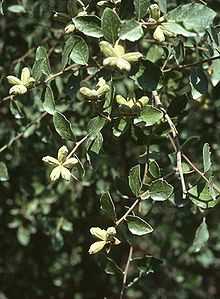Quillaja saponaria
| Soap bark tree | |
|---|---|
 | |
| Scientific classification | |
| Kingdom: | Plantae |
| (unranked): | Angiosperms |
| (unranked): | Eudicots |
| (unranked): | Rosids |
| Order: | Fabales |
| Family: | Quillajaceae |
| Genus: | Quillaja |
| Species: | Q. saponaria |
| Binomial name | |
| Quillaja saponaria Molina | |
| Wikimedia Commons has media related to Quillaja saponaria. |
Quillaja saponaria, the soap bark tree or Soapbark, is an evergreen tree in the family Quillajaceae, native to warm temperate central Chile. In Chile it occurs from 32 to 40° South Latitude approximately. Populations are found even 2000 m (6500 ft) above sea level. It can grow to 15–20 m (50–65 ft) in height. The tree has thick, dark bark, smooth, leathery, shiny, oval evergreen leaves 3–5 cm long, white flowers 15 mm diameter borne in dense corymbs, and a dry fruit with five follicles each containing 10-20 seeds.
Characteristics
The inner bark of Quillaja saponaria can be reduced to powder and employed as a substitute for soap, since it forms a lather with water, owing to the presence of a glucoside saponin, sometimes distinguished as quillaia saponin. It also applied as an agricultural spray adjuvant. The same, or a closely similar substance, is found in soapwort (Saponaria officinalis), in senega root (Polygala senega) and in sarsaparilla; it appears to be chemically related to digitonin, which occurs in digitalis. The wood is used in cabinetry, and scents derived from the tree are used in perfumes and cosmetics.
Uses
Soap bark tree has a long history of medicinal use with the Andean people who used it especially as a treatment for various chest problems.[1] It is the source of quillaia, the extract of which is used as a food additive and as an ingredient in pharmaceuticals, personal care products, and fire-fighting foam. It is used as additive for photographic films and foaming for drinks. The saponin content of the bark helps to stimulate the production of a more fluid mucous in the airways, thus facilitating the removal of phlegm through coughing.[2] The saponins of this tree are also considered to have adjuvant properties for vaccine solutions.,[3] QS21 adjuvant is a saponin obtainable from Quillaja saponaria extract.[4]
Habitat

This tree occurs at altitudes to 2000 metres.[5] The species is drought resistant, and tolerates about -12°C (10°F) in its natural habitat[6] Examples of specific occurrences are in central Chile in the forests of La Campana National Park and Cerro La Campana, in which locales it is associated with the Chilean Wine Palm, Jubaea chilensis.[7] It is often used for reforestation on arid soils. It has been introduced as an ornamental in California. Trees have been acclimatized in Spain but are rarely cultivated there.
See also
References
- C. Donoso. 2005. Árboles nativos de Chile. Guía de reconocimiento. Edición 4. Marisa Cuneo Ediciones, Valdivia, Chile. 136p.
- Encyclopedia of the Chilean Flora. 2009. Quillaja saponaria
- Adriana Hoffmann. 1998. Flora Silvestre de Chile, Zona Central. Edición 4. Fundación Claudio Gay, Santiago. 254p.
- C. Michael Hogan. 2008. Chilean Wine Palm: Jubaea chilensis, GlobalTwitcher.com, ed. Nicklas Stromberg
- J. Taylor. 1990. The Milder Garden. Dent
- Chevallier, Andrew, 1996. The Encyclopedia of Medicinal Plants, Dorling Kindersley, 336p.
- Singh, Manmohan, 2007. Vaccine Adjuvants and Delivery Systems, John Wiley & Sons, Hoboken, New Jersey, 457 pp.
Line notes
- ↑ Chevallier, A., The Encyclopedia of Medicinal Plants, 1996
- ↑ Chevallier, A., The Encyclopedia of Medicinal Plants, 1996
- ↑ Singh, Manmohan, 2007. Vaccine Adjuvants and Delivery Systems, page 193
- ↑ Singh, Manmohan, 2007. Vaccine Adjuvants and Delivery Systems, page 193
- ↑ Encyclopedia of the Chilean Flora, 2009
- ↑ J. Taylor. 1990.
- ↑ C. Michael Hogan. 2008
External links
- "Quillaja saponaria". Encyclopedia of Chilean Flora. Retrieved 2009-06-29.
- "Quillaja Extracts". Quillaja Extract products and more info. Retrieved 2011-01-04.
- "Quillaja saponaria pictures". Chilebosque. Retrieved 2009-06-29.
- "Quillaja saponaria in Barcelona, Catalonya, Spain". Jardí Botànic de Barcelona. Retrieved 2009-06-29.
- "Soapbark tree widely cultivated in California and Chemical benefits". Drug Information Online. Retrieved 2009-06-29.
![]() This article incorporates text from a publication now in the public domain: Chisholm, Hugh, ed. (1911). Encyclopædia Britannica (11th ed.). Cambridge University Press
This article incorporates text from a publication now in the public domain: Chisholm, Hugh, ed. (1911). Encyclopædia Britannica (11th ed.). Cambridge University Press